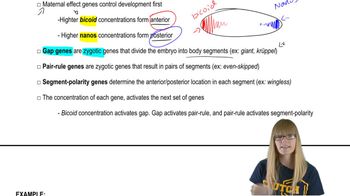Given that maternal Bicoid activates the expression of hunchback, what would be the consequence of adding extra copies of the bicoid gene by transgenic means to a wild-type female with two copies, thus creating a female fly with three or four copies of the bicoid gene? How would the hunchback expression be altered? What about the expression of other gap genes and pair-rule genes?
Table of contents
- 1. Introduction to Genetics51m
- 2. Mendel's Laws of Inheritance3h 37m
- 3. Extensions to Mendelian Inheritance2h 41m
- 4. Genetic Mapping and Linkage2h 28m
- 5. Genetics of Bacteria and Viruses1h 21m
- 6. Chromosomal Variation1h 48m
- 7. DNA and Chromosome Structure56m
- 8. DNA Replication1h 10m
- 9. Mitosis and Meiosis1h 34m
- 10. Transcription1h 0m
- 11. Translation58m
- 12. Gene Regulation in Prokaryotes1h 19m
- 13. Gene Regulation in Eukaryotes44m
- 14. Genetic Control of Development44m
- 15. Genomes and Genomics1h 50m
- 16. Transposable Elements47m
- 17. Mutation, Repair, and Recombination1h 6m
- 18. Molecular Genetic Tools19m
- 19. Cancer Genetics29m
- 20. Quantitative Genetics1h 26m
- 21. Population Genetics50m
- 22. Evolutionary Genetics29m
14. Genetic Control of Development
Developmental Patterning Genes
Problem 16a
Textbook Question
The pair-rule gene fushi tarazu is expressed in the seven even-numbered parasegments during Drosophila embryogenesis. In contrast, the segment polarity gene engrailed is expressed in the anterior part of each of the 14 parasegments. Since both genes are active at similar times and places during development, it is possible that the expression of one gene is required for the expression of the other. This can be tested by examining expression of the genes in a mutant background—for example, looking at fushi tarazu expression in an engrailed mutant background, and vice versa. Given the hierarchy of gene action during Drosophila embryogenesis, what might you predict to be the result of these experiments?
 Verified step by step guidance
Verified step by step guidance1
Understand the hierarchy of gene action during Drosophila embryogenesis. Pair-rule genes like fushi tarazu are expressed earlier in development and help establish the segmented body plan, while segment polarity genes like engrailed refine and maintain the boundaries of these segments.
Consider the role of fushi tarazu in establishing the even-numbered parasegments. If engrailed expression depends on fushi tarazu, then a mutation in fushi tarazu might disrupt engrailed expression in the anterior part of the parasegments.
Analyze the role of engrailed in maintaining segment polarity. If fushi tarazu expression depends on engrailed, then a mutation in engrailed might disrupt the expression of fushi tarazu in the even-numbered parasegments.
Design the experiment to test these predictions. For example, examine fushi tarazu expression in an engrailed mutant background using techniques like in situ hybridization or immunostaining to visualize gene expression patterns.
Interpret the results based on the observed expression patterns. If fushi tarazu expression is unaffected in an engrailed mutant, it suggests that fushi tarazu acts upstream of engrailed. Conversely, if engrailed expression is disrupted in a fushi tarazu mutant, it supports the idea that engrailed depends on fushi tarazu for its expression.
 Verified video answer for a similar problem:
Verified video answer for a similar problem:This video solution was recommended by our tutors as helpful for the problem above
Video duration:
2mPlay a video:
Was this helpful?
Key Concepts
Here are the essential concepts you must grasp in order to answer the question correctly.
Pair-rule Genes
Pair-rule genes, such as fushi tarazu, are crucial in Drosophila embryogenesis as they define the segmentation of the embryo into alternating segments. They are expressed in a pattern that corresponds to every other segment, contributing to the establishment of the body plan. Their expression is essential for the proper formation of segments and influences the development of segment-specific structures.
Recommended video:
Guided course

Segmentation Genes
Segment Polarity Genes
Segment polarity genes, like engrailed, are responsible for establishing the anterior-posterior polarity within each segment of the Drosophila embryo. They are expressed in specific regions of the segments and play a critical role in defining the boundaries and identity of segments. Their activity ensures that each segment develops distinct characteristics and maintains its integrity during development.
Recommended video:
Guided course

Segmentation Genes
Gene Interaction and Mutant Analysis
The interaction between genes during development can be studied through mutant analysis, where the expression of one gene is examined in the absence of another. This approach helps to determine the dependency and regulatory relationships between genes. In the context of fushi tarazu and engrailed, analyzing their expression in mutant backgrounds can reveal whether one gene's expression is necessary for the other, providing insights into their functional hierarchy.
Recommended video:
Guided course

Interacting Genes Overview
Related Videos
Related Practice
Textbook Question
645
views


